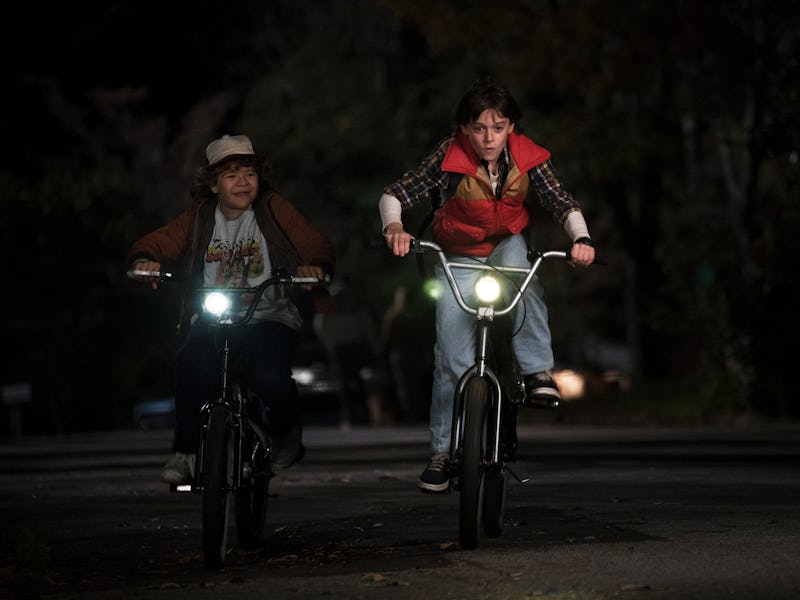BMX Bikes as Symbols of Childhood Freedom on 'Stranger Things'
Taking hints from 1980s hits like 'E.T.' and 'The Goonies', Netflix's newest show gets adolescence right.

Aging means adding a more cynical sheen to the world. The ability to see past simple, potentially fantastic childlike spectacle seems naive because of that very thinking. If this doesn’t seem hopelessly flighty, then perhaps you’re a fan of Netflix’s recent supernatural hit, Stranger Things, a show that borrows the wonder and awe of the best films, books, and TV shows from the 1980s and mixes them into its own blend of sci-fi bliss.
Part of the reason the show has resonated with so many is that it fills a nostalgic hole left by the very films it’s inspired by, ones that partake in a certain sense of sentimentality. They remind us of a time when the only care in the world you had was whether you could go ride bikes with your friends after dinner or not (and maybe fight an inter-dimensional monster before bedtime). That makes their depiction of BMX bikes the kind of ultimate symbol of a certain childhood empowerment, and it carries on through Stranger Things till this day.
The basic idea behind this, obviously, isn’t anything new. Bicycles have long preceded other means of mechanical conveyance, and have always represented a sense of emancipation. You literally get away from something once you hop on that seat and begin pedaling. Fill in the personal details of what you’re escaping from there.
Two wheels is all you need.
But before the Spielbergian fantasy of the 1980s, a bicycle had never really crystallized into a singularly vivid metaphor on-screen like that. There have been depictions of lovable characters in scenes partaking in dual-wheeled freedom, like in the cheery love triangle of Butch Cassidy and the Sundance Kid where Paul Newman ferries Katherine Ross around in circles on a bike outside a farmhouse as “Raindrops Keep Falling on My Head” plays on the soundtrack. A stolen bicycle even provided the spark in Vittorio De Sica’s Bicycle Thieves that highlighted the plight of the everyman in Italian neorealism. Here, bicycles were just supplemental storytelling tools or, at worst, props.
Once the 1980s rolled around, they became full on emblems of the collective audience that watched the actual movies. It wasn’t even that there were films in that decade about cycling, like American Flyers or Quicksilver, or even the absurd kitsch of something like RAD or Australian oddity BMX Bandits. Specifically, the BMX bicycles in films like E.T. and The Goonies extended beyond mere objects to represent the identities of the characters that rode them.
In one of the 1982 film’s most iconic scenes, E.T.’s protagonist Elliott (Henry Thomas) and his friends escape government agents who are after the benevolent alien the pre-teens are hiding. The kids in Spielberg’s film aren’t just escaping on BMXs from dudes with I.D. badges issued by some unknown acronymed agency that hunts aliens. They pedal to freedom because they trying to escape the kind of adult minds that would seemingly dismiss the innocent idea that kids wouldn’t be able to understand inexplicable experiences like an alien landing in suburban California.
Similarly in 1985’s The Goonies, a film directed by Richard Donner and produced by Spielberg from his own story idea, a group of kids must reconcile the demolition of their charmingly ramshackle seaside pacific northwest neighborhood from adult contractors looking to build a swanky country club. After finding a treasure map from a legendary pirate who supposedly hid his priceless booty nearby — which could potentially be used to buy out the country club contractors — the kids set out as a pack of two-wheeled adventurers to save their way of life.
They’re escaping that problem to find a solution on BMX bikes, and retaining their headstrong childhood determination in the process. The visual gag of teenage brother Bran (Josh Brolin) being forced to ride the smallest bike of the bunch (a pink girl’s bike with a basket and streamers), is perhaps the funniest visual gag showing the clash of those adult and adolescent worlds.
In Spielberg’s case, these 1980s films are about how the post-baby boom middle class infatuation had turned away from cars and favored a more innocent and whimsical emblem of youth. It’s a humorous contrast to American Graffiti, the nostalgic-in-its-own-right debut film of the filmmaker’s best friend and collaborator George Lucas that was all about teens cruising in hot-rods. If anything, Lucas’s next film, Star Wars (you may have heard of it) would provide perhaps the ultimate example of a BMX bike: the Millennium Falcon.
But the BMX bike seems to be the great unsung symbol of everything that Spielberg represents and everything subsequently inspired by his films. When choosing the logo for his production company, Amblin, the hitchhiking hippie couple protagonists of his 1968 short film of the same name were overlooked in favor of the indelible image of Elliott and E.T. flying across the moon on a BMX.
Likewise, when choosing to show the bonds of friendship and empowerment between friends in Stranger Things, whether having characters ride home after a rousing campaign of Dungeons & Dragons, escaping from government goons à la E.T., or in the show’s [marketing images]*(http://cdn.collider.com/wp-content/uploads/2016/06/stranger-things-poster-netflix.jpg), series creators Matt and Ross Duffer adopted the BMX bike that would immediately highlight those very themes.
“A bike like this is like a Cadillac to these kids,” Chief Hopper says to a deputy in Stranger Things when trying to make sense of the situation after they find missing kid Will Byers’s BMX in the woods. The significance here is that an adult would use a car as a simile. It’s easy to forget how much freedom you can have on two wheels instead of four, but aren’t Cadillacs more like bikes for adults? In the 1980s and up to now, the answer is most definitely.